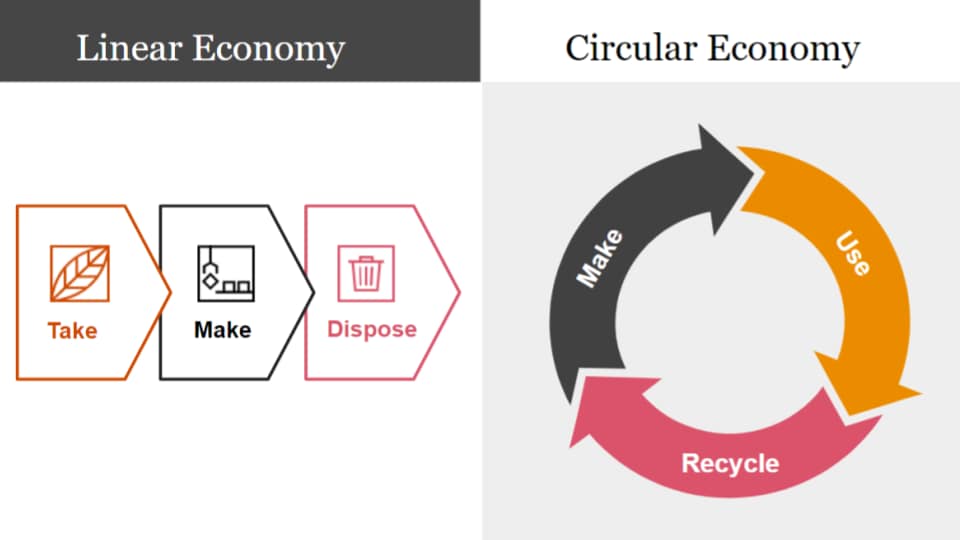The circular economy model
What is the circular economy model?
A circular economy is an alternative economic model, to replace the current linear model of “take – make – waste” (see the following Figure). The model involves using resources efficiently and prioritizing renewable inputs, maximizing a product’s usage and lifetime in order to extract the maximum value and recovering and reusing by-products and waste to make new materials or products.

Elements of the EU circular economy action plan
EU action plan towards circularity
As part of the EU Green Deal, the European Commission moved towards the adoption of an action plan focusing on the design and production for a circular economy and aiming to reduce the EU’s consumption footprint, double its circular material use rate and contribute to economic decarbonization by reducing the EU’s carbon and material footprint.
Key Facts on EU Circular Economy Plan:
- 35 legislative and non – legislative initiatives
- Implementation period from 2020 - 2023
In order to contribute to the transformational change of achieving carbon neutrality by 2050 the Circular Economy action plan as part of the EU industrial strategy presents measures to:
- Make sustainable products the norm in the EU through the implementation of a legislative Sustainable Product Policy, to ensure that products placed on the EU market are designed to last longer, are easier to reuse, repair and recycle, and incorporate as much as possible recycled material instead of primary raw material.
- Empower consumers and benefit from a true ‘Right to Repair'.
- Ensure less waste towards a well-functioning market for secondary raw materials through setting an EU-wide, harmonized model for the separate collection of waste and labelling. The Action Plan also puts forward a series of actions to minimize EU exports of waste and tackle illegal shipments.
- Focus on the sectors that use the most resources and where the potential for circularity is high through launching concrete actions on the following seven key product value chains:

Electronics and ICT
Implementation of a “Circular Electronics Initiative” to have longer product lifetimes and improve the collection and treatment of e-waste.
Plastics
New mandatory requirements for recycled content and special attention on microplastics as well as biobased and biodegradable plastics.
Batteries and vehicles
Application of a new regulatory framework for batteries for enhancing the sustainability and boosting the circular potential of batteries.
Textiles
Implementation of a new EU Strategy for textiles to strengthen competitiveness and innovation in the sector and boost the EU market for textile reuse.
Food water and nutrients
Implementation of a new legislative initiative on reuse to substitute single-use packaging, tableware and cutlery by reusable products in food services.
Packaging
New mandatory requirements on what is allowed on the EU market, including the reduction of (over)packaging.
Construction and buildings
Revision of construction product regulation and creation of a comprehensive Strategy for a Sustainably Built Environment promoting circularity principles for buildings.
Key targets of the EU Action Plan:
70%
Recycle of construction, demolition and excavation waste.
0
Ban of single use plastic.
65%
Recycle of municipal waste by 2035.
3%
Boost Europe’s productivity by 2030.
70%
Recycle of packaging waste by 2030.
0,5%
Increase EU GPD by 2030.
Current trends in Greece
An overview of the Greek legislative and non-legislative initiatives on a path towards the long-term adoption of circular economy principles is given below:
Relevant Initiatives |
Key elements |
Implementation date |
Modernization of Environmental Legislation |
All building permits require legal disposal of rubble.
|
From 2020 |
Ban of plastic bags |
1/1/2021 |
|
Waste Management Plan |
60% of plastic recycling |
By 2030 |
Single plastics such as straws and cutlery are banned |
3/7/2021 |
|
10% reduction on landfill waste |
By 2030 |
|
Rehabilitation of illegal landfills |
By 2030 |
|
Electric Mobility |
20% funding and tax exemption for purchase of electric vehicles |
From 2020 |
Key financial instruments provided by the Greek government and European Commission towards circularity and are running between 2011 and 2020 are given below:
Financial instrument |
Focus area |
Responsible Party |
Funding Budget |
Green Fund |
The Green Fund is a public-law entity towards the development through environmental protection with administrative, economic, technical and financial support coming from programmes, measures and actions aimed at preserving and enhancing the environment, supporting the environmental policy of the country and serving the public and social interest through the administration, management and utilization of its resources. Current relevant initiatives of this programme include the provision of funding in Greek municipalities in order to devise and implement local action plans towards a circular economy. |
Greek Ministry of Environment & Energy
|
55 million € |
Horizon 2020 |
“Connecting economic and environmental gains – the Circular Economy” includes one of the four thematic areas of this programme and consolidates relevant research and innovation (R&I) initiatives in order to foster the implementation of the EU Circular Economy package. |
European Commission |
1 billion € |
COSME |
This programme aims to support the competitiveness of enterprises and small and medium-sized Enterprises (SMEs) and is devoted to ease access to finance in all phases of their lifecycle – creation, expansion, or business transfer and integrate new technologies and business models towards a sustainable and circular industry. |
European Commission
|
2.3 billion € |
InnovFin - EU Finance for Innovators |
In collaboration with EIB, this programme aims to improve access to loan finance for innovative small and medium-sized enterprises and small mid-caps (up to 499 employees) in order to support the transition to a more circular economy. |
European Commission |
Up to 7.5 million € |
LIFE |
This funding programme supports environmental, nature conservation and climate action projects throughout the EU. In compliance with the EU circular economy package, this programme contains more than one hundred LIFE Environment and Resource Efficiency projects illustrating how the circular economy works in practice, establishing new production processes for preventing waste and promoting the use of secondary resources. |
European Commission |
3.4 billion € |
Key targets of the EU Action Plan:








